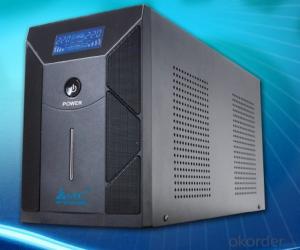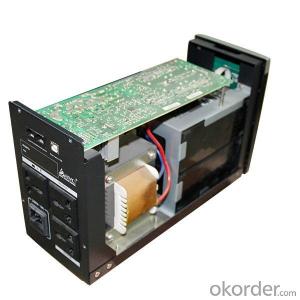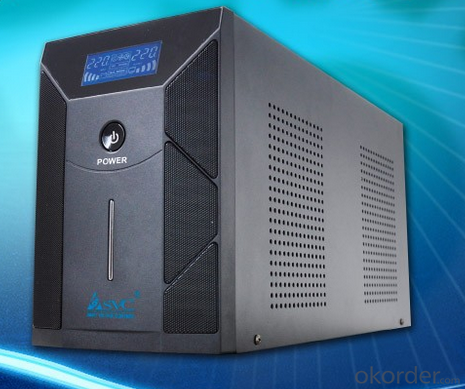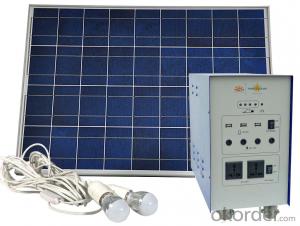Solar Energy Systems Gilbert - Portable Line Interactive Eco 2KVA Computer Battery Home UPS Sine Wave
- Loading Port:
- China main port
- Payment Terms:
- TT OR LC
- Min Order Qty:
- 20 carton
- Supply Capability:
- 10000 carton/month
OKorder Service Pledge
OKorder Financial Service
You Might Also Like
Sine Wave Portable Line Interactive ECO 2KVA Computer Battery Home UPS

| Model | V-2000 | V-3000 | ||
| Capacity | 2000VA/1200W | 3000VA/1800W | ||
| INPUT | ||||
| Input voltage | 110/120Vac or 220/230/240Vac | |||
| Input voltage range | 85~150Vac/175~275Vac | |||
| Frequency range | 60/50Hz/(Auto sensing) | |||
| OUTPUT | ||||
| Output voltage | 110/120Vac or 220/230/240Vac | |||
| Output voltage range | 102~132Vac/200~255Vac | |||
| Output frequency | 60±0.5Hz or 50±0.5Hz(Batt.mode) | |||
| Output wave form | PWM(Batt. mode) | |||
| Transfer time | Typical 2-6ms,10ms max | |||
| BATTERY | ||||
| QTY.&capacity of battery | 12V/7AII×4pcs | 12V/9AII×4pcs | ||
| Charging period | 4-6 hours recover to 90% capacity | |||
| PROTECTION | ||||
| Full Protention | Low voltage&overload&short circuit protection | |||
| PHYSICAL | ||||
| Net weight (kg) | 18.0 | 20.0 | ||
| Unit dimention (mm) | 340*110*265 | |||
| ENVIRONMENT | ||||
| Environment of performance | Temperature 0℃~40℃, Humidity 20%~90% | |||
| Noise level | ≤ 40dB(lm) | |||
| MANAGEMENT | ||||
| LCD or LED, RJ45/11 & USB | Optional | |||


1. Wide range of input voltage
The UPS can offer normal and stable service voltage under its input voltage range. When the input voltage is out of its range the machine will switch to battery mode automatically to keep the output power in order to protect the equipment, such as computers, ensure they will not be damaged by the over high or over low voltage, users can continue the operation of equipment for a while or save the data on computers while the power network is abnormal.
2. Wide range of AVR(Automatic voltage regulation)
In the product’s input voltage range and under 3 steps of intelligent AVR function, it can provide a stable output voltage.
3. Automatic self detection when UPS on(LED).
Before the UPS on, red, yellow, blue LED will light up two times by cycle turns, after self detection UPS switch to AC mode/battery mode or working mode.
4. Silence function
In the "battery mode", shortly press the switch to turn off the buzzer. But the battery is about to run out or the load is too heavy, the buzzer sound cannot be muted.
5. Overload protection
In the battery mode, output voltage turn down correspondingly when it is overload, after the capacity of load is lower than the rated power then output voltage will back to rated value, it ensures the UPS will not shut down by abrupt overload which caused by surging current during the computer is working and other equipment is added.
6. Short circuit protection
When the mis-operation caused the load short circuit or computer failure (such as power tube breakdown of switch) cause short circuit, the UPS will shutdown automatically for protection.
7. The low current switch
This UPS adopts low current switch to extend the service life which is longer than conventional battery and high current switch in AC current path.
8. Automatic charging
There are two charging mode, charging time is faster than ordinary charging mode, higher efficiency, and greatly prolonging the service life of the battery.
9. With a bypass output
Independent bypass output socket for external printers or scanners of computer peripherals, with surge protection of the load.
- Q: How does the angle and orientation of solar panels affect their efficiency?
- The angle and orientation of solar panels greatly impact their efficiency. Solar panels should be angled and oriented in a way that maximizes their exposure to sunlight throughout the day. If the panels are not angled correctly, they may not receive the maximum amount of sunlight, leading to reduced efficiency. Additionally, the orientation of the panels, whether they are facing south or not, plays a crucial role in capturing sunlight. A south-facing orientation is typically the most effective as it allows the panels to receive the most direct sunlight, optimizing their efficiency.
- Q: Can a solar energy system be installed on a shopping center or mall?
- Yes, a solar energy system can be installed on a shopping center or mall. In fact, many shopping centers and malls around the world are now utilizing solar panels to generate electricity. The large rooftop spaces available in these establishments make them ideal for solar installations. By harnessing the power of the sun, shopping centers and malls can significantly reduce their reliance on traditional energy sources, lower their carbon footprint, and reduce their energy costs. Furthermore, solar energy systems can also be integrated into parking lots or carports, providing shade for vehicles while simultaneously generating clean energy. Overall, installing a solar energy system on a shopping center or mall is a viable and sustainable solution for meeting their energy needs.
- Q: Are there any ongoing monitoring requirements for solar energy systems?
- Yes, there are ongoing monitoring requirements for solar energy systems. Monitoring is essential to ensure that the solar energy system is operating efficiently and effectively. It helps in identifying any potential issues or malfunctions, allowing for timely repairs or maintenance. Ongoing monitoring typically involves tracking the system's performance, including energy production, system uptime, and any deviations from expected outputs. This can be done through various monitoring tools and technologies, such as real-time monitoring software, data loggers, or remote monitoring systems. Additionally, some jurisdictions or incentive programs may have specific monitoring requirements to ensure compliance with regulations or eligibility criteria. Regular monitoring helps maximize the benefits of solar energy systems and ensures their long-term performance and durability.
- Q: How do solar energy systems impact the reduction of fossil fuel consumption?
- Solar energy systems have a significant impact on the reduction of fossil fuel consumption. One of the main advantages of solar energy is that it harnesses power from the sun, which is a renewable source of energy. This means that solar energy systems do not require the burning of fossil fuels, such as coal or natural gas, to generate electricity. By using solar energy, we can reduce our dependency on fossil fuels for electricity generation, thereby lowering our carbon footprint and mitigating the negative environmental impacts associated with fossil fuel consumption. Solar energy systems also contribute to the reduction of fossil fuel consumption through the concept of net metering. Net metering allows individuals or businesses with solar panels to sell excess electricity generated back to the grid. This means that during times of high solar energy production, when the system generates more electricity than is being used, the excess energy is fed back into the grid. As a result, less electricity needs to be produced by fossil fuel-based power plants to meet the demand, reducing the overall consumption of fossil fuels. Furthermore, the adoption of solar energy systems can lead to a decrease in the demand for fossil fuel-based electricity, which in turn can drive down the price of electricity. This price reduction can make renewable energy more economically competitive, encouraging greater adoption of solar energy systems and further reducing the demand for fossil fuels. In summary, solar energy systems play a vital role in reducing fossil fuel consumption. By utilizing the sun's energy, solar power systems eliminate the need for burning fossil fuels for electricity generation. Through net metering and the potential for price reductions, solar energy systems contribute to the overall reduction of fossil fuel consumption, promoting a cleaner and more sustainable energy future.
- Q: How does the cost of solar energy compare to other energy sources?
- Solar energy has become increasingly cost-competitive with other energy sources in recent years. While the initial installation costs of solar panels can be higher, the long-term operational and maintenance costs are significantly lower. Additionally, the cost of solar technology has been steadily declining, making it more affordable for consumers and businesses. Moreover, solar energy benefits from abundant and free sunlight, reducing the reliance on expensive and finite fossil fuels. Overall, the cost of solar energy is becoming increasingly comparable and, in some cases, even cheaper than traditional energy sources.
- Q: Can I install solar panels myself?
- Yes, you can install solar panels yourself if you have the necessary knowledge, skills, and experience. However, it is highly recommended to consult with professionals or hire a licensed solar installer to ensure safety, compliance with regulations, and optimal performance of the solar panel system.
- Q: How does the cost of solar panels vary based on the manufacturer?
- The cost of solar panels can vary based on the manufacturer due to several factors. Different manufacturers may use different technologies, materials, and production methods, which can affect the overall cost of the panels. Additionally, brand reputation and market demand can also influence the pricing. Some manufacturers may offer premium panels with higher efficiency and durability, resulting in a higher cost, while others may focus on providing more affordable options. Ultimately, it is important to consider factors like quality, warranty, and long-term performance when comparing prices from different manufacturers.
- Q: Can solar energy systems be used in areas with limited sunlight hours?
- Solar energy systems can indeed be utilized in regions with minimal sunlight hours. Although solar panels generate the highest amount of energy when directly exposed to sunlight, advancements in technology have made it feasible for solar systems to still produce electricity even in areas with limited sunlight. One method to tackle the issue of limited sunlight hours is by installing solar panels that are more efficient at capturing and converting sunlight into electricity. These high-efficiency solar panels can optimize energy production even in areas with reduced sunlight. Additionally, the utilization of tracking systems that tilt and follow the sun's path throughout the day can also aid in increasing energy output. Another approach involves storing excess energy generated during peak sunlight hours in batteries. This stored energy can then be utilized during periods of low sunlight, enabling the solar system to continue powering homes or businesses even in the absence of sunlight. Furthermore, integrating solar power with other renewable energy sources, such as wind or hydroelectric power, can help compensate for limited sunlight hours. By combining different sources, a more reliable and consistent energy supply can be achieved. In conclusion, although limited sunlight may impact the energy production of solar systems, there are numerous technological solutions and strategies that can be employed to make solar energy feasible even in areas with fewer sunlight hours.
- Q: Can solar energy systems be installed on all types of roofs?
- Yes, solar energy systems can be installed on most types of roofs, including flat roofs, sloped roofs, and even curved roofs. However, the suitability of installation may vary depending on factors such as the roof's orientation, angle, shading, and structural integrity. It's important to consult with a professional solar installer to assess the compatibility of a specific roof for solar panel installation.
- Q: Can solar energy systems be used for powering refrigeration or cold storage facilities?
- Yes, solar energy systems can definitely be used for powering refrigeration or cold storage facilities. Solar energy systems are capable of generating electricity that can be used to power various appliances, including refrigeration systems. This is achieved by installing solar panels that capture sunlight and convert it into electricity through photovoltaic cells. The electricity generated by solar energy systems can be stored in batteries or directly used to power refrigeration or cold storage facilities. This is particularly beneficial in remote areas or regions with unreliable power grids, where solar energy can provide a reliable and sustainable source of electricity. Using solar energy for refrigeration or cold storage facilities offers several advantages. Firstly, it helps reduce dependency on traditional energy sources, such as fossil fuels, thereby reducing greenhouse gas emissions and combating climate change. Secondly, solar energy systems have low operating costs as they require minimal maintenance and use a free and abundant energy source. Lastly, solar-powered refrigeration systems can operate during power outages, ensuring the preservation of perishable goods and reducing the risk of food spoilage. In conclusion, solar energy systems can effectively power refrigeration or cold storage facilities, providing a sustainable and reliable source of electricity. By harnessing the power of the sun, these systems can reduce energy costs, minimize environmental impact, and ensure the proper storage and preservation of perishable goods.
Send your message to us
Solar Energy Systems Gilbert - Portable Line Interactive Eco 2KVA Computer Battery Home UPS Sine Wave
- Loading Port:
- China main port
- Payment Terms:
- TT OR LC
- Min Order Qty:
- 20 carton
- Supply Capability:
- 10000 carton/month
OKorder Service Pledge
OKorder Financial Service
Similar products
Hot products
Hot Searches
Related keywords






















